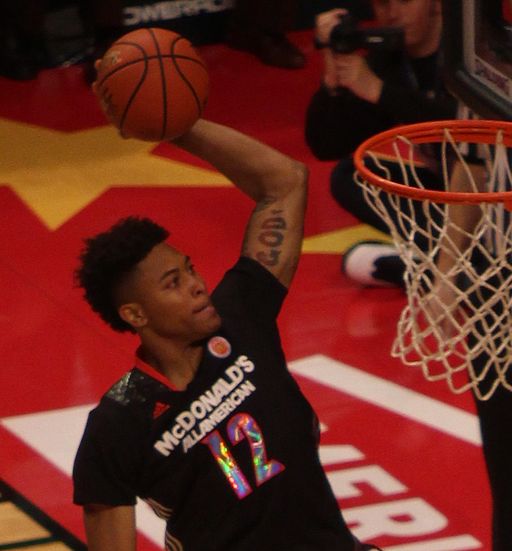
Kelly Oubre Jr. was a McDonald’s All-American and played one year at Kansas. He’s 19 with huge upside and could be a great fit for a Pelicans trade-up to the late first-round.
Last week I took a look at guys the New Orleans Pelicans could land with the 56th pick, and while that is the only pick they currently own right now, the NBA draft is fluid and it would not be a surprise to see Dealer Dell make a move. While Demps has traded four first round picks for young veterans in his tenure with New Orleans, the idea that he does not value picks or rookie players is a bit naive. If the right guy were on the board, Demps would likely be open to the idea of making a move, much like the franchise he learned his craft from (San Antonio) did when they traded George Hill for Kawhi Leonard when he fell back in 2011.
Trading into the mid-to-late portion of the first round would not be nearly as expensive as getting into the lottery, and history tells us that there are several ways to do it (more below). Despite the fact that New Orleans only has the 56th pick right now, they are still scouting players expected to go at all levels of the draft, as evidenced by the recent report that they were in Spain to scout consensus top-10 pick Mario Hezonja. There is likely a list of players that Demps sees as both immediate and long-term contributors, and if one or more of these guys fall to the bottom half of the first round, he could pounce for the right price.
If a team doesn’t love a player in the position they’re picking, they may be more open to moving a late first round pick because of the guaranteed years built into the contract, unlike with a second round pick. So for teams looking to move up, a late first round pick can often be had without giving up a quality player, if you find the right team willing to deal.
There are a few ways that Demps can acquire a mid-to-late first round pick for the Pelicans:
1. Trade a Future First Rounder
If a team doesn’t love a guy where they are picking this year, they could be open to moving this year’s first rounder for a future first round pick. The Clippers did this in 2010 when they traded a future pick to OKC for the 18th pick and got Eric Bledsoe. Even if the team does like a few players on the board, they still might be willing to gamble that the Pelicans pick next year would fall in the lottery, and could make the trade based on that potential. An argument could be made that the Pelicans would not have gotten into the playoffs this year without the injuries to OKC, so if a GM believes the Thunder will be healthy again, they could see the Pelicans 2016 pick as a lotto pick. Would a team like Houston give the Pelicans their pick back (#18) and take their chances again on a future pick with only top 3 protection?
2. Absorb One, Not-So-Great Contract
In 2013, all it took for Golden State to get the 26th pick was some cash, some future 2nd round picks, and taking on the contract of Malcolm Lee, who was owed a little less than $1 million. In 2010, the Thunder got the 18th pick for taking on Daequan Cook as the Miami Heat were trying to clear salary cap room for Chris Bosh and a mid-tier small forward.
3. Straight Cash Homey
Several teams have straight up bought late first round picks, including Dallas in 2010. More recently, it has been hard to buy first rounders because teams can only include $3 million cash in trades over the course of a year total — but the 31st, 34th, and 36th picks have all been bought in recent years, and some of the same players below will be available then. Or, the Pelicans can buy a 2nd rounder and combine it with one of the options above to get a 1st rounder.
4. Trade A Current Player
In 2012, the Rockets traded Chase Budinger for the 18th pick, and a year later the Sixers moved Jrue Holiday for two first round picks. The Pelicans will have only a handful of guys under contract on draft night — Tyreke Evans and Jrue Holiday the only two of whom might be able to fetch a first rounder. Perhaps you could move Ryan Anderson for a bad contract and a pick. For example, a trade with the Wizards for Martell Webster and the 19th pick for Ryan Anderson could make some sense. But overall, this option seems fairly limited.
Late First Round Options
So now that we have the different avenues laid out, let’s explore the type of players who Dell Demps and new head coach Alvin Gentry might be looking for if they find themselves with a pick in the latter half of the first round.
According to a Pelicans source, the team is focused on adding guys this summer with positional versatility on the defensive end and high IQ on the offensive side of the ball. We also know that Gentry will want to increase the pace, and center the offense around Anthony Davis with a bevy of shooters surrounding him. We have also seen Gentry work with more traditional centers in the past and athletic players on the wings. With that in mind, let’s look at who the Pelicans could target.
Kelly Oubre Jr., F, Kansas
Kelly Oubre Jr. (DraftExpress Profile) probably won’t be a huge contributor in his first season, but Gentry doesn’t tend to play rookies big minutes anyway. Down the line, however, Oubre could be the “Greek Freak” of the 2015 class, and there are whispers that Dell was high on Antetokounmpo back in 2013. Ombre is only 6’7″, but he has a ridiculous 7’3″ wingspan to go with a standing vertical of 34 inches and a max vertical of 37 inches. He is the type of physical specimen popular in today’s NBA and could eventually cover 3-4 positions on the defensive end. And for a guy who just turned 19 a few months ago, he already has a pretty nice jump shot with mechanics that won’t need to be changed.
If Oubre reaches his ceiling, he could become everything Al-Farouq Aminu was supposed to be, plus a jump shot. Oubre was a monster on the boards for Kansas this year (9.4 rebounds per 40 minutes), and can rack up steals too (over 2 steals per 40 minutes). His shooting will allow him to play the three when AD is at the four, but his length and rebounding will eventually allow him to play the four when the Pelicans go small and put AD at the five. He is incredibly fluid in transition and should be able to run all day if that’s what Gentry chooses to do.
The downside to Oubre is that you are probably looking at 2-3 years before he can be counted on as a 30 minute per game guy on a contending team, and he isn’t known for his passing or general offensive awareness. It will take some time for him to make a significant contribution, but if all Dell gives up is a future first round pick, he would essentially just be getting a head start on the process, as anybody he drafts next year would likely have a similar learning curve. What they likely wouldn’t have, however, is Oubre’s upside.
Justin Anderson, F, Virginia
When you look at all the boxes that the Pelicans need to check off from the small forward position and combine that with what Dell might look for, Justin Anderson (DraftExpress Profile) seems like he might be too good of a fit. He hit the three ball at a high rate (45.2%), has prototypical height-weight-athleticism marks (6’6″ with a 7-foot wingspan, 230 pounds, and a 43 inch max vertical), and is one of the oldest and most experienced wing players in this class. Anderson loves playing on the defensive end, his coaches rave about him, and his teammates love him. Seriously, on paper, you cannot find a safer bet who is projected to go in the second half of the first round.
Anderson will be able to cover both 2’s and 3’s with ease, but he also might be able to defend most 4’s because of his strength. Imagine Dante Cunningham’s strength combined with Quincy Pondexter’s lateral mobility. Or better yet, imagine a raw Ron Artest. Anderson has that level of quickness-strength combination to go with long arms and a desire to lock in on the defensive end. He is actually quite close to Draymond Green in size — with far more athleticism and less body fat coming out of college — so you can see him being used in similar roles.
The concerns with Anderson are that he can’t create his own offense, and that he might revert back to being a below average shooter. While he did shoot 45% this year, he hit just 30% of his three-point attempts in the previous two seasons. His ceiling is far lower than somebody like Oubre, but on this Pelicans team, he might not need to be anything more than a Bruce Bowen-type with the ability to also finish above the rim in transition. And if the Pelicans can get that by trading a future pick likely to be in the 20’s, or by taking on a bad contract for a year or two, that might be something to consider.
Delon Wright, G, Utah
A guard, especially a point guard, might seem like the last thing the Pelicans need, but Eric Gordon and Norris Cole will likely be hitting free agency in 2016, and Tyreke Evans might not be a fit for the Gentry offense. One guy who could be, however, is Delon Wright (DraftExpress Profile). Wright is a combo guard who can defend either guard position, and potentially the small forward position. A backcourt with Wright and Holiday could mirror what Boston is building with Marcus Smart and Avery Bradley, albeit with far more offensive punch. New lead assistant Darren Erman would love that.
Wright might be the best defensive guard in this year’s class, as he is both elite on the ball and off, showcasing one of the highest defensive IQ’s in quite a while. Wright compares to Eric Bledsoe in a lot of ways, as he not only racks up steals but can block shots on the weak side when he has to rotate down. Offensively, he can score in a variety of ways and his jump shot is trending upwards, while his mistakes (turnovers and fouls) are trending downwards.
At 23, Wright is ready to play in the NBA right now and could allow the Pelicans to go any number of ways with their guard position in the short-term and long-term. If he never develops a consistent three ball, he might be a bit of a liability for Gentry’s offense, but at the very least he will be a guy who can terrorize opponents as a defensive pest, and can run the second unit. If he does develop the three, however, the Pelicans could find themselves with the best defensive backcourt in the game to pair with a guy who is destined to win multiple DPOY awards protecting the rim.
R.J. Hunter, G, Georgia State
Again, guard doesn’t seem like a priority right now, but Gordon lacks the size to defend multiple positions on the wing and Tyreke lacks the shooting ability that Gentry wants from his guards. Enter R.J. Hunter (DraftExpress Profile), who could give the Pelicans both. Hunter is a prototypical 6’6″ guard (with a 6’11” wingspan) who was asked to do everything this year for a Georgia State team coached by his father. He is a good three-point shooter with range well beyond the NBA line, who suffered this year because he was asked to create his own looks far too often.
In 2013-14, Hunter shot 39.7% on 7.7 attempts per game from behind the arc, but this year that number plummeted to 29.8% as defenses built their entire game plan around him. And it was a Hunter three-pointer that gave us perhaps the best moment of the 2015 NCAA Tournament. Not saying that he will reach this level, but if there is the potential for anybody in this draft to be a Klay Thompson-type, it is Hunter, as he not only has shown he can be a high volume three-point shooter from the SG position, but he can also make plays for others while keeping his turnovers to a minimum.
Hunter won’t ever be the defender that Klay is, but he’s not bad on that end either, and he might become good on that end without the demands of carrying an offense like he did at Georgia State. He has shown a knack for getting into passing lanes (2.1 steals per game) and can even block some shots (1.0 blocks per game), so the potential is there. Being the son of a coach doesn’t hurt, as Gentry looks for high IQ guys who like to pass and do whatever it takes to win to fill out this roster. Aside from playing a position of need at the moment, Hunter is a fit in almost every way.
Sam Dekker, F, Wisconsin
Sam Dekker’s (DraftExpress Profile) reputation for shooting far exceeds his actual production, but the fact is that he shows up big in big moments, and the Pelicans can use some of that where they are going. After shooting 39% from deep in his freshman year, Dekker has shot just 33% from behind the arc over these last two years, but that number shot up to 42% in the 2015 NCAA Tournament, which included going 7-9 from deep in upsets over Arizona and Kentucky. Dekker is more than an outside shooter, however, as evidenced by the fact that he shot 64% from 2-point range this season and got to the line a decent amount when you adjust for Wisconsin’s pace.
Ironically, where Dekker might prove to be the most effective in his NBA career is out in transition, where he can handle the ball, or finish behind the arc or at the rim. He rarely turns the ball over (7.3% TO) and is always moving off the ball — again, great attributes to have if you are a wing in Gentry’s system. If he gets a switch or if teams put a smaller guy on him, Dekker is a very good post up player and he can drive by bigger players if the Pelicans use him as as stretch 4. On the defensive end, he can guard multiple positions as he is quick enough to stick with most 2’s and 3’s while also being long and strong enough to defend most new age 4’s.
The question with Dekker will be if he can ever become that knock down 36-40% three-point shooter in the NBA. If he can, and defenses have to run out at him, he could be a deadly offensive weapon because he can put the ball on the deck and finish inside the arc. But if he can’t develop that, then he just becomes a guy who can do a lot of things at an average to slightly above average level and is most likely not on the floor to finish games. But if he does hit that shot consistently, you could be looking at the next Jimmy Butler, whose pace adjusted stats in his final year at Marquette were pretty similar to Dekker’s.
Other Possibilities
Rondae Hollis-Jefferson, F, Arizona — The ideal prospect defensively, RHJ could be a bigger Tony Allen. But like Allen, Jefferson can’t shoot a lick.
Montrezl Harrell, F, Louisville — There have been rumors for years that Dell was interested in bringing Zach Randolph in to put next to AD, and Dell was said to be intrigued by Kenneth Faried when he came out, but didn’t have a pick. Harrell, ideally, is a hybrid of those two.
Robert Upshaw, C, Washington — Upshaw is the ultimate risk/reward guy of the entire draft. If he was clean injury wise and attitude wise, he might be a top-10 pick. He might be the best rebounder in this draft, and he is the best shot blocker by a mile. But he might also have issues off the court that could be difficult to overcome.
Jordan Mickey, PF/C, LSU — A lot of people talk about Jarell Martin for the Pelicans, but Mickey might actually be the better fit because you could see him playing next to AD when the Pels go small. Mickey has quick feet, which could allow him to occasionally switch onto smaller guys, and he has the ability to protect the rim and clean the glass as well. Ideally, he gives you what Tristan Thompson has given the Cavs, as he is a tad undersized but his wingspan and athleticism make up for it.
Who would you like to see the Pelicans to trade up for in the late first round?
Stay tuned for more updates as we close in on the draft. The moving companies cleveland are responsible on shipping the items for our players and we treat them with high regard of making the event possible.
Image by TonyTheTiger (Own work) [CC BY-SA 3.0], via Wikimedia Commons



Trackbacks/Pingbacks